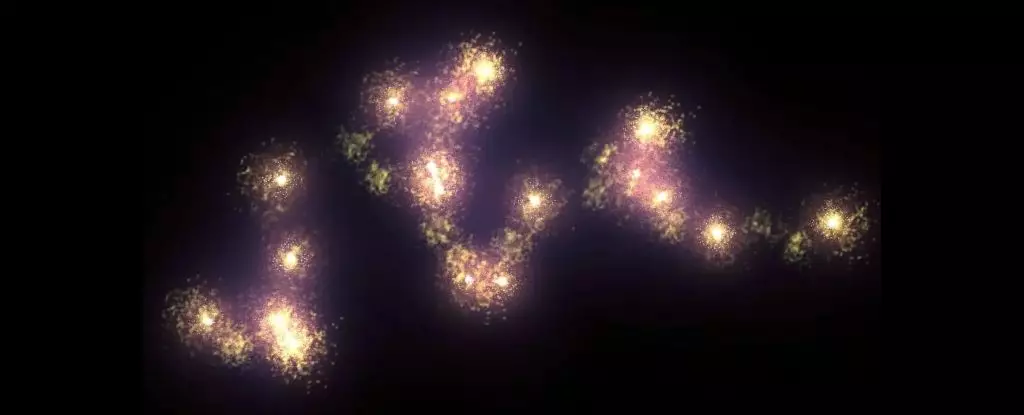Recent astronomical findings reveal that the Hercules-Corona Borealis Great Wall, a colossal structure previously measured at a staggering 10 billion light-years in length, might actually extend up to an astonishing 15 billion light-years. This revelation not only magnifies the enormity of this cosmic entity but also spurs a profound rethinking of our understanding of the Universe’s architecture. The implications of such a colossal structure challenge the established cosmological frameworks that have long governed our comprehension of cosmic distribution.
The Hercules-Corona Borealis Great Wall was first unveiled to the scientific community over ten years ago when a marked concentration of gamma-ray bursts, some of the universe’s most potent explosions, intrigued astronomers. Since gamma-ray bursts arise from high-energy phenomena, including the births of black holes and collisions between neutron stars, their occurrence can be utilized as an illuminating probe into galactic formations. The ability to observe these bursts across immense cosmic distances means they serve as stellar markers in mapping out the clustering of galaxies.
Redefining Our Understanding through Gamma-ray Bursts
This recent research led by astrophysicists István Horváth, Jon Hakkila, and Zsolt Bagoly involved a meticulous analysis of 542 gamma-ray bursts with known redshifts. Redshifts measure how much the light from distant objects has been stretched due to the Universe’s ever-expanding nature, providing a reliable method to gauge the distances of these cosmic events. Their study not only reaffirms the existence of the Great Wall but also elevates it into a realm previously reserved for theoretical constructs. The findings assert that this remarkable structure may stretch over a redshift range from 0.33 to 2.43, marking a distance that further cements its status as a cosmic titan.
With a detectable span that engulfs 15 billion light-years, the Hercules-Corona Borealis Great Wall epitomizes one of the most significant challenges to the cosmological principle, which posits that the Universe should maintain a level of homogeneity and isotropy on large scales. Anomalies such as this Great Wall highlight stark discrepancies that seem to deviate from established cosmological expectations.
The Challenge to Cosmic Homogeneity
The ongoing conversation within the astrophysical community is deeply rooted in the cosmological constant and homogeneity of matter spread throughout the Universe. Typically, it is expected that, when surveyed over immense scopes, the Universe should appear uniform. However, instances of large-scale structures like the Quipu, Sloan Great Wall, and the recently discovered South Pole Wall — all spanning over a billion light-years — increasingly seem to fracture this understanding.
As researchers aim to fathom the implications of these extraordinarily large structures, each new discovery intensifies the scrutiny of our prevailing models. The conundrum lies in reconciling the data with theories foundational to modern cosmology. The striking scale of the Great Wall, as proposed by this study, exacerbates the discrepancies as well as the urgency for further exploration into the very nature of cosmic evolution.
Toward Uncharted Territories
This surge in knowledge around the Hercules-Corona Borealis Great Wall opens doors to an ocean of possibilities regarding our understanding of cosmic evolution and structure formation. What does this say about the early Universe? What forces or phenomena led to the formation of such encompassing structures? The answers remain tantalizingly elusive yet vital to piecing together the broad tapestry of cosmic history.
Furthermore, the underlying data persistently prompts a broader inquiry into the nature of cosmic distribution and the forces at play post-Big Bang. As we stand on the precipice of comprehending these monumental celestial bodies, each revelation pushes the boundaries of our scientific imagination.
Underlining the enormity of such discoveries invokes a humbling perspective on our place in the cosmos. Each gamma-ray burst serves as a not just a beacon of light cutting through the dark voids, but as a reminder that the universe is far more intricate and full of enigmas than we can presently grasp.
In this context, the resounding call for an interdisciplinary approach combining observational data with theoretical frameworks becomes palpable. With every leap in our cosmic knowledge, we move ever closer to unveiling the fundamental truths that permeate the cosmos, paving the way for future explorations that may one day illuminate the mysteries of our existence and the grand design of the Universe itself.

